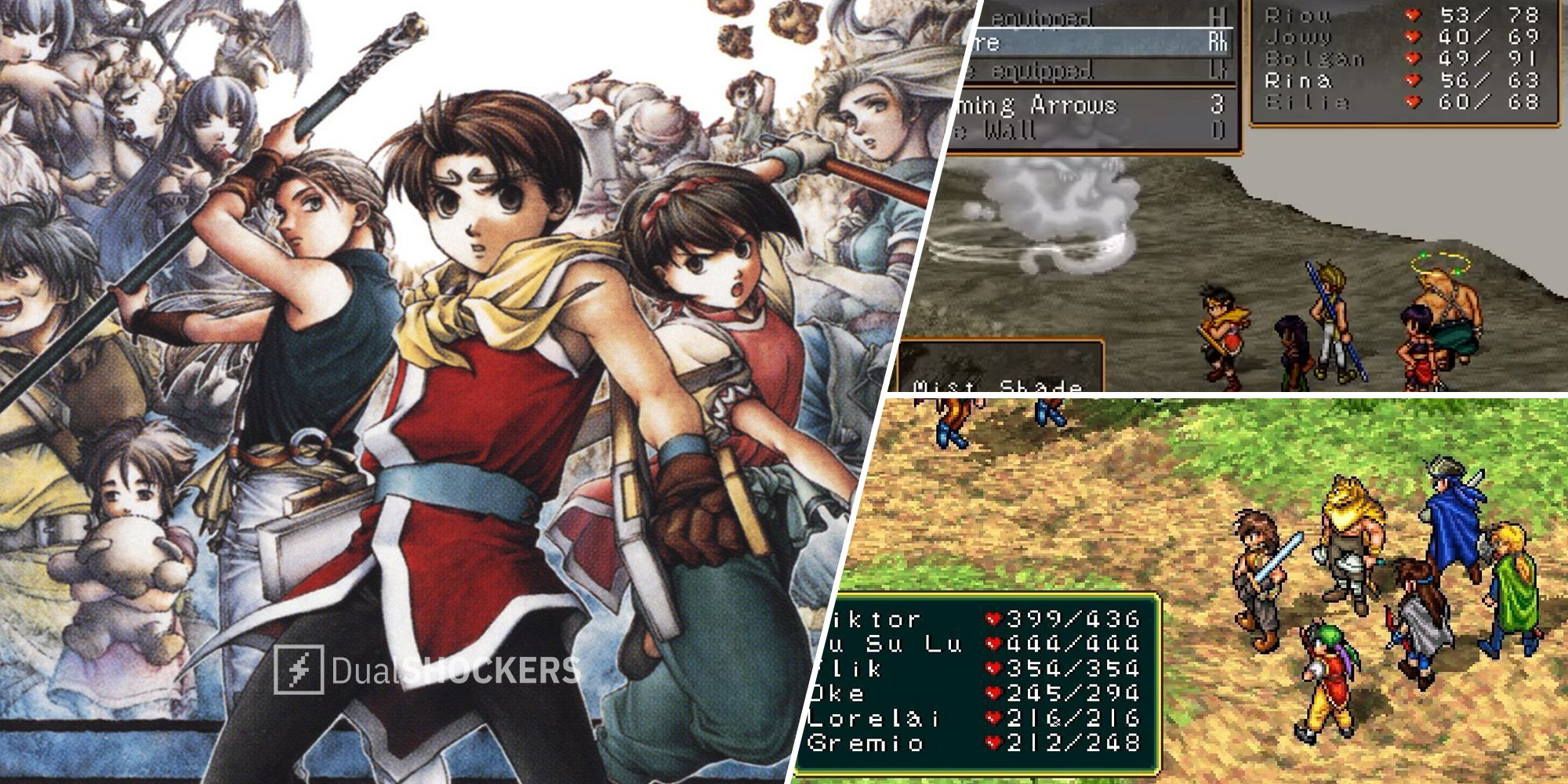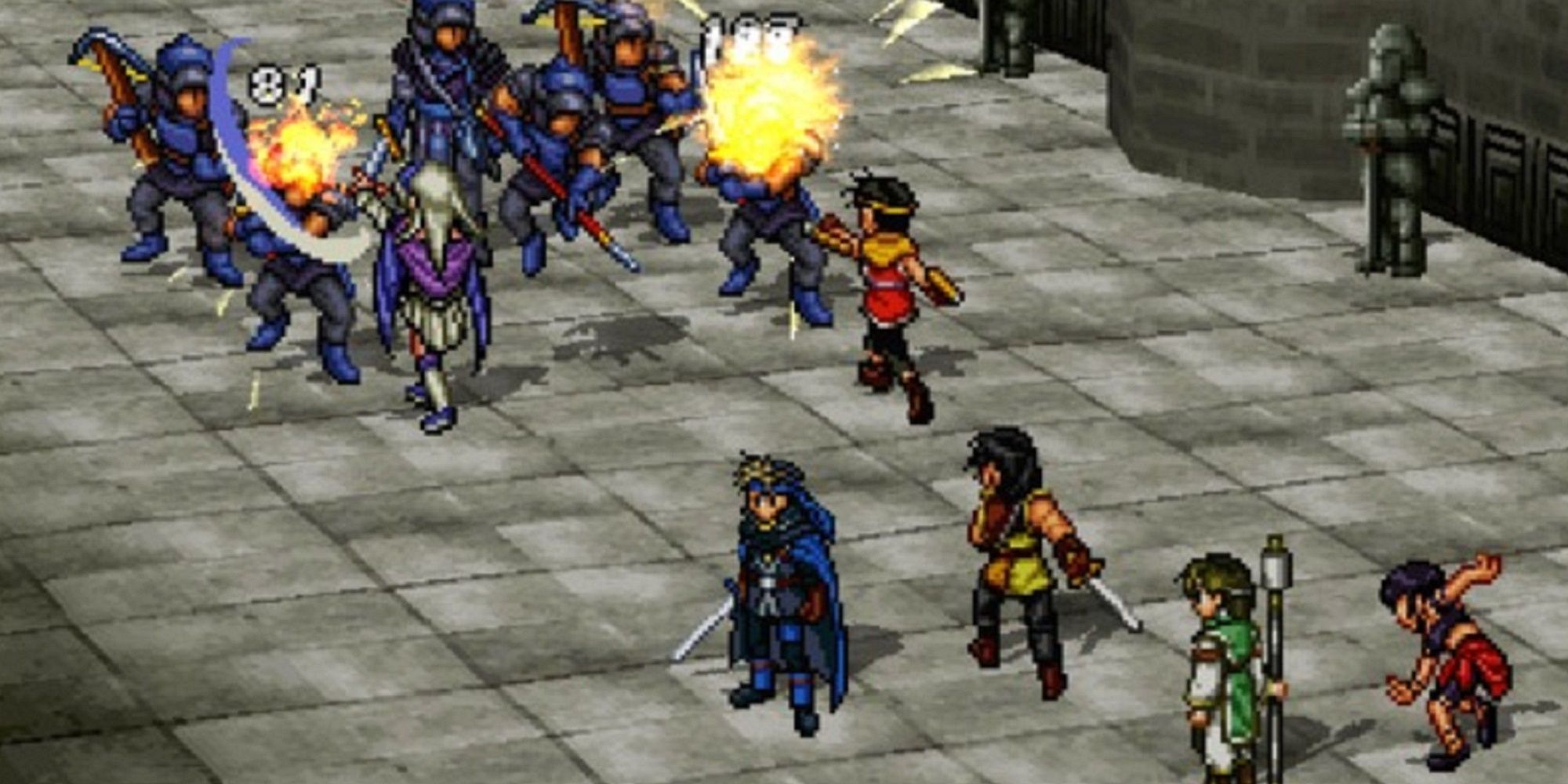Remastered versions of the first two games in the Suikoden series are coming next year, with updated pixel animations, touched-up character portraits, and upgraded sound. It’s great news for series’ fans, and I could only be more thrilled if Konami had announced they were bringing the full series back for modern-day fans (but let’s just see how these two pan out before getting carried away).
This series passed me by in its run on the original PlayStation, which hosted the two games currently set for remastering. But as a JRPG completionist and, at the time, a poor college student who couldn’t afford to buy more than one AAA title per semester, I fell hard for Suikoden III’s charming art style, massive collection of recruitable characters (108 in every single game), and its compelling story of a war from five different perspectives — six if you count the dog.
So years later, when my local game store placed a thick, antiquated jewel case containing the series’ progenitor at the apex of its central pedestal, with a three-digit price tag I still couldn’t afford, I decided a few weeks of surviving on just cup ramen was worth the experience of living the story’s origin for myself. And I was right. Because the Suikoden series isn’t just a great story; it’s a revolution in the way we’d experience JRPG battles for years to come.
On their surface, the early Suikoden games may seem like standard fare for JRPG enthusiasts — you talk to people in towns and castles, wander the map, then the screen flashes and you fight some monsters. So far, so standard. But the basic battles have an extra layer of depth to them that really set them apart. What’s more, there were two additional battle modes you had to master to advance past key points in the story.
Most of the battles followed a standard turn-based format – you choose each of your character’s actions, then a round begins, then the action plays out. Rinse and repeat until the bad guys are dead. But with 108 requitable characters, the number of possible combinations in your party was astronomical, and several of them came with unique special skills and combo attacks, so long as their preferred partners were present.
As you played through the game, you’d collect runes, with each character capable of equipping three of them at a time. Runes played a variety of roles, from opening up special attacks to granting access to different elemental magic, or even helpful skills like doubling your speed on the overworld map. There was no MP or mana counter either, as the game relied on four different levels of spell slots akin to tabletop RPGs. This meant if you have a character with a water rune – which was usually healing magic – and a lighting rune – which was attack-based – you had to pick and choose how to spend your spell slots until your next rest. While you could probably keep firing off small heals and bolts for an entire boss battle, you were usually limited to one or two big spells, which made timing and planning crucial when it came to magic.
Square’s JRPGs had received massive praise in the ’90s for its innovative approach to combat and character augmentation, but Suikoden held right with them. Chrono Trigger released just nine months ahead of Suikoden and had a not too dissimilar combat system, while Final Fantasy VII’s materia system had a lot of parallels with runes.
The Suikoden series is about war — both the grit and the camaraderie. While some of the 108 characters you can recruit are essential to the story and come equipped with a full set of plot armor, the rest are there to fill a variety of roles – from padding out your standard six-person party to adding special features to your base of operations. For example, there’s a bowtie-wearing poindexter named Window who bears the Window Rune and can help you change the cosmetic look of your text window (I promise that’s the least creatively named character in the series).
Even with the minor characters, you’ll be spending a good chunk of your time in these games traversing the continent, trying to fill up your castle not with faceless drones but with fun and quirky people with their own dreams and desires of getting back to a peaceful life after the war.
Here’s the kicker: during battle they can all die.
The battles are pretty simple in theory and work on a rock-paper-scissors basis, except with infantry-cavalry-archery. Each round, you choose one of your officers to lead their troops onto the field – all with their own power levels – and the opposing commander will do the same. But even a type advantage won’t guarantee victory in a skirmish, and a lapse in judgment could cost the lives of some of your precious companions, as well as locking you out of the best ending. It’s something that hadn’t been played around with much at the time; seeing your friends mowed down before you and realizing you’re doing the same thing to the other side is a stark reminder of the price of war.
And here’s where things get really tense. A lot of the time, these deaths are going to happen right after a major army battle, as Tir, Riou, or whatever character you’re playing goes head-to-head in a duel with that chapter’s big bad. Sure, your army has dominated or maybe just scraped by, but as Zoe from Firefly would put it, “This is something the captain has to do on his own.”
In a way, these duels take place in much the same manner as the large-scale army battles of the first two games. They still follow a rock-paper-scissors style system, but this time, a powerful attack beats a standard attack, a standard attack beats defense, and defending against a powerful attack results in a counter with massive damage. You can usually try to anticipate your opponent’s next move via their speech window between rounds. “Can you break my invulnerable defenses?” (pictured above) is pretty straightforward to interpret, but that’s just the first duel in the series, and as you start fighting against old friends and allies, you’ll have to play on their more subtle emotional inferences just to survive; that’s not even taking into account the icy-hearted black knight Yuber, who only ever says “…” (it’s not so fun when the antagonist gets to be silent too, is it?).
I came into this series in the third of five main-series installments, and there are two spinoffs as well, each with their own twists and turns to the politics of war. The third game’s army battles have you assemble four-person squads and issue movement commands à la Ogre Battle, but all you can do as commander is watch their AI-driven actions and hope they make it through alive. The fourth game introduces turn-based naval battles (take notes, Skull and Bones, you’ll get there), and the final installment tries to take the best of everything the series had put together thus far, even upping the tension on duels by placing you on a countdown timer.
While Suikoden has its die-hard fan base, it’s never really caught fire in the west like the Final Fantasy and Dragon Quest games of the same era did. Hopefully the remastered editions don’t stop with the second installment, because taking a stroll through all seven Suikoden titles would really showcase the evolution of battle.



